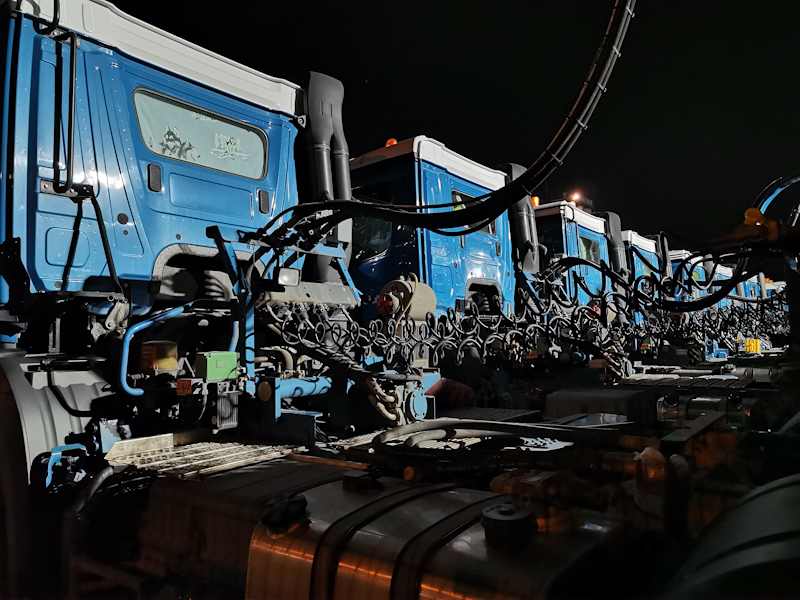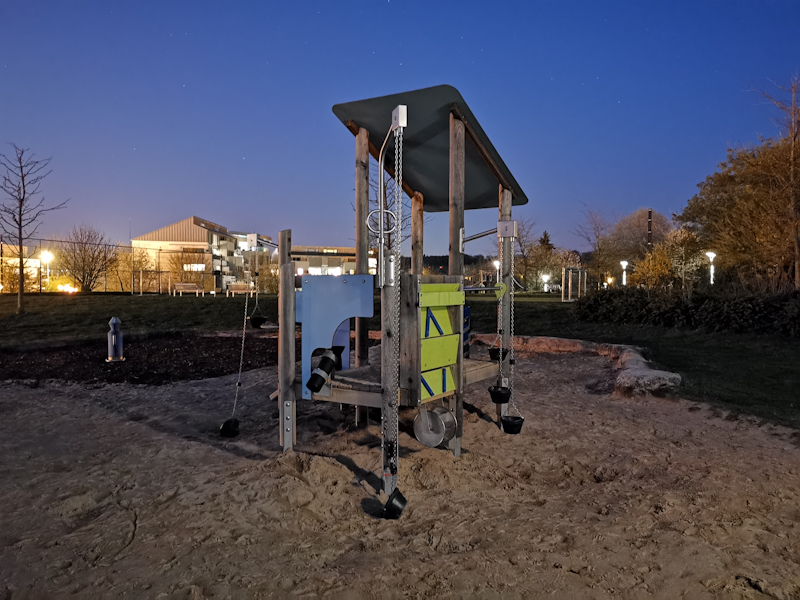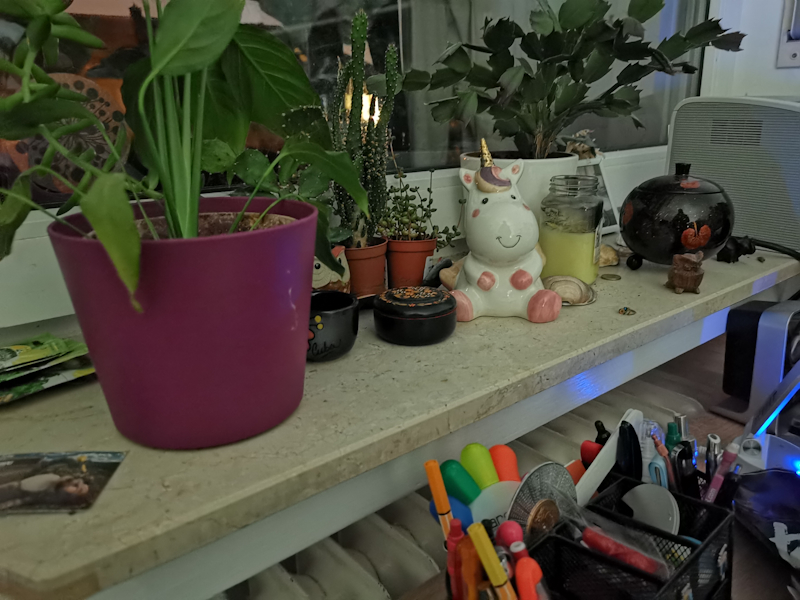The Huawei P30 & P30 Pro Reviews: Photography Enhanced
by Andrei Frumusanu on April 18, 2019 9:00 AM EST- Posted in
- Mobile
- Smartphones
- Huawei
- P30
- P30 Pro
Camera - Low Light Evaluation
Low-light photography is where Huawei’s strengths lie. Starting with the P20 the company was a pioneer in terms of computational photography, not only was the company able to improve low-light capture on smartphones with “regular” camera sensors, it also marked the start of customised camera sensor hardware that was able to achieve much higher ISO sensitivity than any other phone camera on the market.
Huawei’s rationale for adopting the RYYB sensor was in order to improve the low-light capabilities of the phone, promising 30% increased light capture. The P30 Pro in particular we’re expecting some massive low-light capture improvements, not only due to the new sensor but also thanks to the wider aperture as well as the integration of OIS in the sensor – something we haven’t seen in Huawei devices in several years.

[ P30 Pro ] - [ P30 ]
[ P20 Pro ] - [ P20 ] - [ Mate 20 Pro ]
[ S10+ (S) ] - [ S10+ (E) ] - [ S9+ (S) ]
[ G8 ] - [ G7 ] - [ V40 ]
[ View20 ] - [ OnePlus 6T ] - [ Pixel 3 ] - [ iPhone XS ]
As a note, shooting in 40MP mode in low light is pretty much a futile exercise, as the sensor just isn’t able to capture enough light without help of pixel binning down to 10MP.
Huawei had already a lead in low-light capture with its previous devices, and the only viable competition was the new Pixel’s Night Sight mode. With the P30s, Huawei now extends this lead. While not exactly reaching the level of detail on the Pixel 3’s Night Sight mode, the P30s both show very large improvements over their 40MP predecessors all while being leagues ahead of other traditional camera sensors.
It’s to be noted the Pixel 3’s Night mode was way off in terms of colour temperature, and the Huawei phones had a more correct representation of the orange illumination of sodium street lamps.
At certain brightness levels such as in this scene, Night mode on the Huawei phones can have a detrimental effect and results in blurred details, even though it produces a brighter image.
Both wide angle modules struggle in low-light, however Night mode can help out a lot. Again between the four wide angle shots between the P30 Pro and P30 we’re getting very different results, with the smaller P30 producing brighter results for some reason.

[ P30 Pro ] - [ P30 ]
[ P20 Pro ] - [ P20 ] - [ Mate 20 Pro ]
[ S10+ (S) ] - [ S10+ (E) ] - [ S9+ (S) ]
[ G8 ] - [ G7 ] - [ V40 ]
[ View20 ] - [ OnePlus 6T ] - [ Pixel 3 ] - [ iPhone XS ]
In this parking lot, again in regular shooting mode the P30s are ahead of the competition, with the only real contender being Google Night mode. Switching on the P30’s we see better exposure and shadows, although Google continues to retain a detail lead.
On the wide-angle camera, Huawei’s Night mode remains unchallenged. LG’s G8 comes near in terms of exposure, however it lacks details and is very noisy. Samsung’s new cameras are lagging far behind in this aspect.

[ P30 Pro ] - [ P30 ] - [ P20 Pro ] - [ P20 ]
[ Mate 20 Pro ] - [ S10+ (S) ] - [ S10+ (E) ] - [ S9+ (S) ]
[ G8 ] - [ G7 ] - [ V40 ] - [ View20 ]
[ OnePlus 6T ] - [ Pixel 3 ] - [ iPhone XS ]
This shot is quite challenging due to the high dynamic range between the illuminated truck cabins and the dark lower parts of the image. In the default mode, both P30s produced too dark images with not sufficient dynamic range, however on the P30 Pro the phone captures an evident HDR processed picture. I didn’t do anything special between takes, and this is something I’ve experienced in the past with Huawei devices. Unfortunately the phone has like a dozen capture modes which get triggered depending by scene, and one has little control over it and the result can only be determined by the resulting EXIF information in the image.
When in Night mode, the P30’s produce better shadows than the Pixel, however the latter continues to have an advantage in terms of detail. The Pixel is also a tad too saturated with the blue of the trucks, while the Huawei phones are too undersaturated.
Camera - Extreme Low-Light Evaluation
Moving on to extreme low-light conditions, these are scenarios we traditionally didn’t expect smartphones cameras to be effective at all. Most phones here will produce a dark image and are at their limit in terms of light capture. To be able to perform here, you need help of specialised sensors or sneaky computational photography.

[ P30 Pro ] - [ P30 ] - [ P20 Pro ] - [ P20 ]
[ Mate 20 Pro ] - [ S10+ (S) ] - [ S10+ (E) ] - [ S9+ (S) ]
[ G8 ] - [ G7 ] - [ V40 ] - [ View20 ]
[ OnePlus 6T ] - [ Pixel 3 ] - [ iPhone XS ]
In our playground shot in the night, the P30 Pro pulls in some incredible amount of light. The auto shot comes in at ISO25600, however due to the noise reduction you’re hard to notice any noise at all.
The smaller P30 had issues in terms of focusing correctly, and thus it resulted in a blurry shot.
Switching on Night mode, the P30 Pro is able to capture some outstanding results far ahead of any other device. The inclusion of OIS on the P30 Pro really augments the Night mode, and while in past devices we saw more blurred details in this mode, on the P30 Pro things actually get a lot sharper.
The Pixel 3’s Night mode can’t keep up here as even if it’s algorithmically superior, the sensor just isn’t able to capture enough input data.
Comparing the P30 Pro to say the iPhone XS really showcases the massive differences that we’re currently seeing in the competitive landscape, and the differences are absurd.

[ P30 Pro ] - [ P30 ] - [ P20 Pro ] - [ P20 ]
[ Mate 20 Pro ] - [ S10+ (S) ] - [ S10+ (E) ] - [ S9+ (S) ]
[ G8 ] - [ G7 ] - [ V40 ] - [ View20 ]
[ OnePlus 6T ] - [ Pixel 3 ] - [ iPhone XS ]
In this last in-door shot, the absurdity continues as the P30s are just in a different league. Again between the P30 Pro and the P30 we see the former take advantage of OIS and a resulting sharper picture.
Both phones in the auto mode area already ahead of the pack in terms of capture ability, but turning on the Night mode further widens the gap, achieving even more detail. I was actually aghast to see how natural the resulting image was, yet the actual room was much darker than what’s represented here.
P30 Pro & P30 Low-Light Evaluation Conclusion
Overall, Huawei here hit it out of the park in terms of low-light capture. The new sensors as well as the new optics on the P30 Pro really put the devices far ahead of the curve in terms of what they’re able to produce.
OIS for the P30 Pro in particular has notable benefits, especially when paired together with the Night mode. Huawei’s processing for Night mode is a lot brighter than previous devices. Google still seems to have the better algorithms and resulting Night Sight pictures can be a lot sharper and more detailed than Huawei’s Night mode, however under a certain threshold of low light even the Pixel 3 can’t keep up with Huawei’s new camera modules.
The P30 Pro is the best low-light camera smartphone on the market, with the P30 closely following behind. The competition really needs to scramble to improve their computational photography abilities, and be at least be able to match Google’s implementation. If we’ll see other vendors employ special sensors such as employed by Huawei is to be seen, but for now the company’s cameras are in a class of their own in low-light.










85 Comments
View All Comments
BabelHuber - Tuesday, April 23, 2019 - link
Just try to fix a bug via Magisk without root, or install a system-wide ad blocker (not only in the browser, but for each and any app). Or try to install a black overlay on WhatsApp or Instagram with the Samsung theme engine 🙄No, you simply don't get the features of substratum and Magisk without root.
zeeBomb - Monday, May 6, 2019 - link
Any specificiations of the Purism 5? Enticing device, looks like it's taking a jab to BBM...marko94 - Saturday, April 20, 2019 - link
im an accountant and tech lover, but until i have a reliable information of the actual cost of manufacturing a device, i wont necessarily call it overpriced. expensive. maybe, not overpriced. there's a difference.cpkennit83 - Sunday, April 21, 2019 - link
Average selling price will be down by 250€ in 2 months. If thats not proof enought the device is overpriced i dont know what is. Not specific to Huawei though, Samsung does it too. Only Apple and One plus tend tonstick to the same price for the entire life of the deviceMightyGadget - Sunday, April 21, 2019 - link
I had exactly the same thoughts on the 5x telephoto zoom, which I have not seen many people mention. I did use the phone at the same time as the Black Shark 2 recently and loved having the zoom over 2x that the Black Shark offered, but I think 3x is a bit more versatile. But yeah, in most cases, I think people will benefit from the low light photography more than 5x & 10x zoom.They should just add another 3x telephoto lens for next years model!
WPX00 - Monday, April 22, 2019 - link
The value equation with the S10 is wildly better for the P30 here in Asia. In Indonesia:P30 8/128: IDR 10 million (709 USD)
P30 Pro 8/256: IDR 13 million (922 USD)
S10e 6/128: IDR 10.5 million (745 USD)
S10 8/128: IDR 13 million (922 USD)
S10+ 8/128: IDR 14 million (993 USD)
The P30 is both lower priced and comes with double the storage of the base S10+, and is the same cost with the S10 vanilla with double the storage.
s.yu - Thursday, April 25, 2019 - link
You do get a notably worse screen, speakers, and SoC with the P30, also the expensive proprietary storage, and the build is questionable as they're still holding on to the scratchable plastic sandwich screen construction from the P20.To some people with certain needs the P30 may be of better value than the S10, but it's still the worst in value by far of almost all Chinese smartphones. At this price range go get a Reno 10x version, get a top tier Mi9, the latest Meizu or Oneplus 7 or anything else.
s.yu - Thursday, April 25, 2019 - link
BTW, look for grey imported Samsung as they're often cheaper (I did a 10-second search and found the SD855 ver. 8/128 S10 at CNY4650 which is less than USD690 on Taobao, the Exynos ver. 8/128 S10 at CNY 4158, while the "official" local price is CNY5999, lol), whereas you probably won't find any grey imported Chinese smartphones. They're without official warranty but I'm on my third smartphone without a warranty and I've never encountered an issue nor regretted the savings.ezekiel68 - Tuesday, April 23, 2019 - link
That one time I read a review of the Huawei P30 family and came to understand that the Honor View20 was all I wanted and more at a better price. (Yes, I know it's the same parent company)Roy2002 - Friday, April 26, 2019 - link
Huawei has the best cameras now.